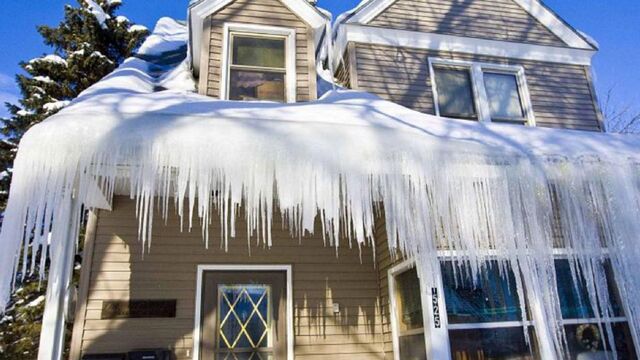
Ice dam damage costs Utah homeowners thousands of dollars every winter, but it’s almost entirely preventable. At Gutter Boys, we’ve developed a proven 5-step process that keeps ice dams away from your property year after year.
Ice dams don’t happen overnight—they’re the result of predictable conditions that you can control with the right approach. Following these five steps costs a fraction of what you’ll spend on a single ice dam removal service or water damage repair.
Step 1: Complete Fall Gutter System Cleaning
Your ice dam prevention strategy starts with thorough fall cleaning of your entire gutter system. This isn’t just about removing visible leaves—we’re talking about comprehensive cleaning that addresses every drainage component.
Gutter cleaning removes debris that creates ice formation points throughout winter. Leaves, twigs, and accumulated sediment don’t just block water flow—they create uneven surfaces where ice can grab hold and begin building up.
Timing matters too. We recommend complete system cleaning in late October or early November, after most leaves have fallen but before the first serious freeze. This ensures your gutters are completely clear when winter weather arrives.
Don’t forget gutter inspection during this step. Look for loose fasteners, sagging sections, or damage that could affect water flow. Small problems discovered in fall are much easier to fix than emergency repairs during winter storms.
Step 2: Professional Downspout Cleaning and Inspection
Downspouts are often the forgotten component of ice dam prevention, but they’re absolutely critical for proper system function. A single clogged downspout can cause backup that leads to ice formation throughout your entire gutter system.
Downspout cleaning & repair involves more than checking for visible blockages. Professional cleaning includes water testing to identify restrictions deep in the system and joint inspection to ensure proper connections.
We’ve found everything from tennis balls to bird nests in downspouts, but the most common problems are accumulated debris and separated joints that restrict water flow. These issues become major problems when snow melts and drainage capacity becomes critical.
Proper downspout function prevents water from backing up into gutters where it sits and freezes, becoming the foundation for ice dam formation.
Step 3: Strategic Heat Tape Installation
Heat tape installation is where science meets practical application. The goal isn’t to heat your entire roof—it’s to create strategic heated pathways that prevent ice formation in critical areas.
Our heat cable installation process focuses on three key zones: roof edges where ice dams typically start, gutter systems where water needs to flow freely, and downspouts where drainage must continue even in freezing temperatures.
Self-regulating heat tape automatically adjusts output based on temperature conditions. When it’s really cold, it works harder. When temperatures rise, it scales back. This provides effective ice prevention while minimizing energy costs.
Installation should happen before the first snowfall when weather conditions allow safe roof access. Proper cable placement creates continuous heated pathways from roof edges through gutters and down through downspouts.
Step 4: Gutter System Repairs and Upgrades
Prevention systems work best when your underlying gutter infrastructure is in excellent condition. Fall is the ideal time to address gutter repair needs before winter weather puts additional stress on your system.
Sagging gutters create low spots where water pools and freezes, even with heat tape installed. Sometimes prevention planning reveals that gutter replacement is the most cost-effective long-term solution.
Seamless gutter installation provides the ideal foundation for ice dam prevention systems. Fewer joints mean fewer potential failure points and more consistent water flow.
Gutter guards complement heat tape systems by reducing debris accumulation that can interfere with proper drainage and heat distribution.
Step 5: Winter Monitoring and Maintenance
Ice dam prevention requires ongoing attention throughout winter to maintain peak effectiveness. Regular monitoring helps identify problems before they become expensive disasters.
Monthly visual inspections should focus on areas where ice formation typically begins. Look for icicle formation, ice buildup despite heat tape operation, or signs that water isn’t draining properly.
Heat tape system monitoring includes checking electrical connections and ensuring cables aren’t damaged by snow loads. Snow removal around downspout outlets ensures proper drainage continues during heavy snow periods.
If ice formation occurs despite your prevention system, don’t attempt DIY removal. Professional ice dam removal services address problems safely while protecting your prevention infrastructure.
Integration and Investment Value
The key to successful ice dam prevention is understanding that all five steps work together as an integrated system. Heat tape without clean gutters won’t work effectively. Clean gutters without proper downspout drainage create backup problems.
Following our 5-step process requires upfront investment, but most homeowners see prevention systems pay for themselves within two to three winters through avoided damage. Many insurance companies offer discounts for homes with proper ice dam prevention systems.
Beyond financial benefits, prevention systems provide peace of mind throughout winter months. You’ll sleep better knowing your home is protected.
Conclusion
Ice dam prevention doesn’t require complicated technology—it requires systematic attention to the factors that cause ice formation. Our 5-step process addresses every aspect of ice dam prevention, from infrastructure maintenance to active heating systems.
Don’t wait until ice dams form to take action. Prevention is always more effective and less expensive than emergency response.
Ready to implement comprehensive ice dam prevention for your home? Get your free quote today and let’s design a 5-step prevention system that’ll keep your home safe all winter long.